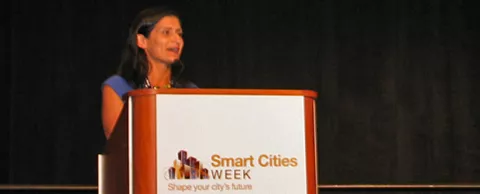
Simone Brody worked in high level occupations in the public and private sectors before heading up the What Works Cities initiative which, among other things, is committed to help cities accelerate their data use to help people improve their lives. But after working with a large number of cities, Brody and her organization identified key lessons from cities that are doing their smart city upgrades and transformations right. She summarized them during the closing session of the Smart Cities Week conference in Washington, D.C. Thursday – and we wanted to briefly share them with you. – Doug Peeples
When What Works Cities was launched by Bloomberg Philanthropies in 2015, it was focused on helping 100 mid-size American cities use data in a way that supports local government decision making, improves services and engages citizens with their city.
Executive Director Simone Brody has learned quite a lot during her tenure with the organization working with a large number of cities, their leaders and staff. During the closing session for Smart Cities Week she boiled it down into four primary points. We share them here:
- Commitment: Long-term success in projects is driven by a commitment from leadership up front, from the very beginning. City mayors need to keep what they're doing – initiating an open data policy for the city for example – in front of the public. Tell citizen what you're going to do; tell them what you're doing while you're doing it, then tell them how and why what you did was good for them and for the city.
- Build capacity: In other words, build a skilled team of employees. Energize and educate existing employees and recruit new talent if needed. Add enrichment opportunities for employees that can allow them to take on more responsibility or new positions. There are a lot of technology jobs that require training, but not a college degree. Also, train employees in a way that they think of their position as not only their job, but also their responsibility.
- Listen to all voices: For lasting change, the kind of change that sticks beyond administrations, "Listen to all the voices in your community," as Brody put it. She recommended using technology to reach beyond what may be a small core of people who always respond to city requests for input – technology such as online surveys, text messaging and others. And, she reminded, include low income citizens too.
- Cross sector collaboration: This is simply the concept of getting city leaders and staff together with engaged citizens and other stakeholders to come up with an understanding of what it is they're trying to accomplish and how to measure how well they're doing it. The point is success is more likely if everyone involved has a shared understanding of what success means in a specific situation, a consensus. Collectively establishing goals makes success that much easier to measure.



